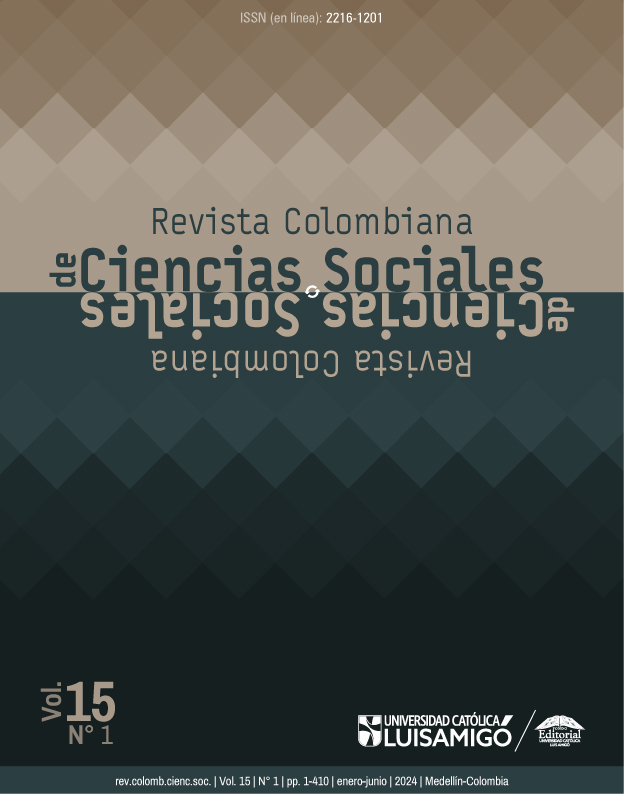Why are we so susceptible to biases derived from facial perception?
DOI:
https://doi.org/10.21501/22161201.4852Abstract
“I don’t judge people.” You’ve probably heard this expression on more than one occasion. However, the reality is very different. If there’s one thing, we’ve learned from decades of research on biases derived from facial perception, it’s that judgments associated with first impressions are virtually unavoidable. You could say that we are predisposed to judge, even if we don’t always
do it intentionally.
Downloads
References
Bar, M., Neta, M., & Linz, H. (2006). Very first impressions. Emotion, 6(2), 269-278. http://dx.doi.org/10.1037/1528-3542.6.2.269
Cone, J., Mann, T. C., & Ferguson, M. J. (2017). Changing our implicit minds: how, when, and why implicit evaluations can be rapidly revised. Advances in Experimental Social Psychology, 56, 131-199. https://doi.org/10.1016/bs.aesp.2017.03.001
Dion, K., Berscheid, E., & Walster, E. (1972). What is beautiful is good. Journal of Personality and Social Psychology, 24(3), 285-290.
Eagly, A. H., Ashmore, R. D., Makhijani, M. G., & Longo, L. C. (1991). What is beautiful is good, but...: A meta-analytic review of research on the physical attractiveness stereotype. Psychological Bulletin, 110(1), 109-128. https://doi.org/10.1037/0033-2909.110.1.109
Graham, J. R., Harvey, C. R., & Puri, M. (2017). A corporate beauty contest. Management Science, 63(9), 3044-3056. https://doi.org/10.1287/mnsc.2016.2484
Griffin, A. M., & Langlois, J. H. (2006). Stereotype directionality and attractiveness stereotyping: Is beauty good or is ugly bad? Social Cognition, 24(2), 187-206. https://doi.org/10.1521/soco.2006.24.2.187
Gutiérrez-García, A., Beltrán, D., & Calvo, M. G. (2019). Facial attractiveness impressions precede trustworthiness inferences: lower detection thresholds and faster decision latencies. Cognition and Emotion, 33(2), 378-385. https://doi.org/10.1080/02699931.2018.1444583
Hahn, A. C., DeBruine, L. M., & Jones, B. C. (2018). Are attractive men’s faces masculine or feminine? The importance of controlling confounds in face stimuli. Journal of Experimental Psychology: Human Perception and Performance, 44(10), 1716-1722. https://doi.org/10.1037/a0016457
Hartung, F., Jamrozik, A., Rosen, M. E., Aguirre, G., Sarwer, D. B., & Chatterjee, A. (2019). Behavioural and neural responses to facial disfigurement. Scientific Reports, 9, 8021. https://doi.org/10.1038/s41598-019-44408-8
Heintzelman, S. J., Mohideen, F., Oishi, S., & King, L. A. (2020). Lay beliefs about meaning in life: Examinations across targets, time, and countries. Journal of Research in Personality, 88, 104003. https://doi.org/10.1016/j.jrp.2020.104003
Jaeger, B., Evans, A. M., Stel, M., & van Beest, I. (2019b). Explaining the persistent influence of facial cues in social decision-making. Journal of Experimental Psychology: General, 148(6), 1008-1021. https://doi.org/10.1037/xge0000591
Jaeger, B., Evans, A. M., Stel, M., & van Beest, I. (2019a). Who judges a book by its cover? The prevalence, structure, and correlates of lay beliefs in physiognomy. https:// psyarxiv.com/8dq4x/
Jaeger, B., Todorov, A. T., Evans, A. M., & van Beest, I. (2020). Can we reduce facial biases? Persistent effects of facial trustworthiness on sentencing decisions. Journal of Experimental Social Psychology, 90, 104004. https://doi.org/10.1016/j.jesp.2020.104004
Jamrozik, A., Oraa Ali, M., Sarwer, D. B., & Chatterjee, A. (2019). More than skin deep: Judgments of individuals with facial disfigurement. Psychology of Aesthetics, Creativity, and the Arts, 13(1), 117-129. https://doi.org/10.1037/aca0000147.
Kahneman, D. (2011). Thinking, fast and slow. Macmillan.
Kirshenbaum, J. M., & Miller, M. K. (2021). Judges’ experiences with mitigating jurors’ implicit biases. Psychiatry, Psychology and Law, 28(5), 683-693. https://doi.org/10.1080/13218719.2020.1837029
Olivera-La Rosa, A. (2018). Wrong outside, wrong inside: A social functionalist approach to the uncanny feeling. New Ideas in Psychology, 50, 38–47. https://doi.org/10.1016/j.newideapsych.2018.03.004
Olivera-La Rosa, A., Arango-Tobón, O. E., & Ingram, G. P. (2019). Swiping right: face perception in the age of Tinder. Heliyon, 5(12), e02949. https://doi.org/10.1016/j.heliyon.2019.e02949
Olivera-La Rosa, A., Villacampa, J., Corradi, G., & Ingram, G. P. (2021). The creepy, the bad and the ugly: exploring perceptions of moral character and social desirability in uncanny faces. Current Psychology, 1-11. https://doi.org/10.1007/s12144-021-01452-w
Olivola, C. Y., & Todorov, A. (2010). Elected in 100 milliseconds: Appearance-based trait inferences and voting. Journal of nonverbal behavior, 34, 83-110. https://doi.org/10.1007/s10919-009-0082-1
Olivola, C. Y., Eubanks, D. L., & Lovelace, J. B. (2014). The many (distinctive) faces of leadership: Inferring leadership domain from facial appearance. The Leadership Quarterly, 25(5), 817-834. https://doi.org/10.1016/j.leaqua.2014.06.002
Olivola, & Todorov. (2017). The biasing effects of appearances go beyond physical attractiveness and mating motives. Behavioral and Brain Sciences, 40, e38. https://doi.org/10.1017/s0140525x16000595
Rhodes, G. (2006). The evolutionary psychology of facial beauty. Annual Review of Psychology, 57, 199-226. https://doi.org/10.1146/annurev.psych.57.102904.190208
Stern, C., & Rule, N. O. (2018). Physical androgyny and categorization difficulty shape political conservatives’ attitudes toward transgender people. Social Psychological and Personality Science, 9(1), 24-31. https://doi.org/10.1177/1948550617703172
Stewart, J. E. (1985). Appearance and punishment: The attraction-leniency effect in the courtroom tribunales. The Journal of social psychology, 125(3), 373-378. https://psycnet.apa.org/doi/10.1080/00224545.1985.9922900
Todorov, A., Pakrashi, M., & Oosterhof, N. N. (2009). Evaluating faces on trustworthiness after minimal time exposure. Social Cognition, 27, 813-833. https://doi.org/10.1521/soco.2009.27.6.813
Todorov, A., Olivola, C. Y., Dotsch, R., & Mende-Siedlecki, P. (2015). Social attributions from faces: Determinants, consequences, accuracy, and functional significance. Annual Review of Psychology, 66(1), 519–545. https://doi.org/10.1146/annurevpsych-113011-143831.
Villacampa, J., Ingram, G. P., Corradi, G., & Olivera-La Rosa, A. (2019). Applying an implicit approach to research on the uncanny feeling. Journal of Articles in Support of the Null Hypothesis, 16(1), 11–22.
Workman, C. I., Bilici, N., Chatterjee, A., & Humphries, S. (2022, 19 de mayo). Normalizing Anomalies with Mobile Exposure (NAME). https://doi.org/10.17605/OSF.IO/B9G6V
Downloads
Published
How to Cite
Issue
Section
License

This work is licensed under a Creative Commons Attribution-NonCommercial-NoDerivatives 4.0 International License.
La revista y los textos individuales que en esta se divulgan están protegidos por las leyes de copyright y por los términos y condiciones de la Licencia Creative Commons Atribución-No Comercial-Sin Derivar 4.0 Internacional.











